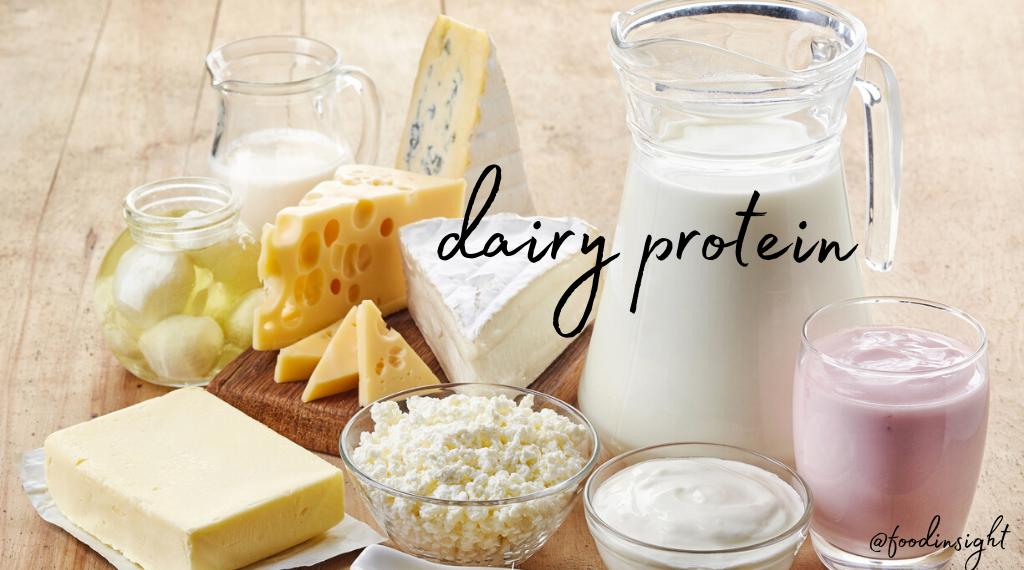June is National Dairy Month and a great time to celebrate all that dairy has to offer. We recently wrote about dairy production—how foods like milk, yogurt and cheese get from the cow to the carton—and in this article we’ll focus on one of dairy’s important nutritional contributions: protein.
What is protein?
At its simplest, a protein is a chain of amino acids bound to one another and resembling a string of beads. These strings get twisted and folded into a final protein shape. When we eat protein, it gets broken down into its individual amino acids, which can be reassembled into whatever type of protein our body needs at that time.
Why do we need protein?
Dietary protein plays a vital role in every cell of our bodies: Proteins provide energy, catalyze metabolic reactions and provide structure to our tissues and organs. It’s an essential nutrient for maintaining muscle strength, bone health and blood sugar control. Protein-rich foods contain many of the vitamins and minerals needed to support body defenses and promote quicker healing. Eating protein-rich foods may also help you meet and maintain your weight goals by satisfying hunger and reducing the urge to snack between meals. The importance of quality nutrition is even greater as our appetite and calorie needs decrease with age; preserving our body’s muscle tissue by maintaining protein intake allows us to stay active.
What makes dairy protein distinct?
Dairy foods contain two major forms of protein: whey and casein. Eighty percent of milk’s protein content comes from casein and the remaining 20% is whey. Whey is rapidly digested, while casein is digested more slowly, providing a more prolonged entry of amino acids into the bloodstream. When making foods like yogurt or cheese, excess liquid that contains whey protein is strained away, leaving a solid or semi-solid product that may have a higher casein-to-whey proportion compared with milk.
Different dairy foods can have different amounts of protein per serving. This is often due to the processing steps used to make each type of product. For example, yogurt varieties like Greek yogurt and Icelandic skyr are typically thicker in texture and higher in protein than traditional yogurt. This difference is due to the fact that they are strained one or two more times than regular yogurt, which removes additional liquid, concentrates the product and increases the amount of protein found in one serving. Also, low-fat milk may have a slightly higher protein content per serving compared with whole milk, since removal of some fat increases the proportion of protein per serving. On the opposite end of the dairy–protein spectrum, ice cream has only a few grams of protein per serving—it’s higher in added sugar and calories compared with many other dairy products—and butter has almost no protein, since it’s almost completely made up of fat.
Like other animal-based foods, milk, yogurt and cheese are considered high-quality sources of protein because they contain all essential amino acids, which our bodies cannot make and which we need to get through our food. In comparison, most plant-based milk alternatives are lacking in one or more essential amino acids (soymilk is one exception to this). Often, plant-based dairy alternatives have less protein per serving than cow’s milk. Dairy foods are a protein option for both omnivores and lacto-vegetarians (who consume dairy products but not animal meat).
How much protein do dairy foods provide?
This table summarizes the protein content of different dairy foods:
Food | Serving Size | Protein Content (in grams) |
Greek yogurt | 6 ounces | 17 |
Cottage cheese, 2% | ½ cup | 11.8 |
Mozzarella cheese | 1.5 ounces | 10 |
Cheddar cheese | 1.5 ounces | 9.6 |
Yogurt, plain, low fat | 6 ounces | 9 |
Milk, 1% | 1 cup | 8.2 |
Milk, whole | 1 cup | 7.7 |
Ice cream | ½ cup | 2.3 |
Butter | 1 Tablespoon | 0.1 |
Table Source: U.S. Department of Agriculture, Agricultural Research Service. FoodData Central, 2020.
It’s recommended that adult females consume at least 46 grams of protein per day, and adult males should aim to get at least 56 grams per day. Some groups, like pregnant and breastfeeding women as well as athletes, have elevated protein needs, and older adults may also benefit from eating more protein. A few servings of dairy can provide a sizable amount of the protein we need daily.
What are the key takeaways?
Protein plays an indispensable role in maintaining our health as part of a nutritious diet. Protein contributions from different dairy products can vary significantly, so if you choose to consume dairy, it’s important to pick foods like milk, yogurt and cheese that offer a high nutritional bang for their buck. Reading Nutrition Facts labels can help you select the protein-rich dairy product that’s right for you.
